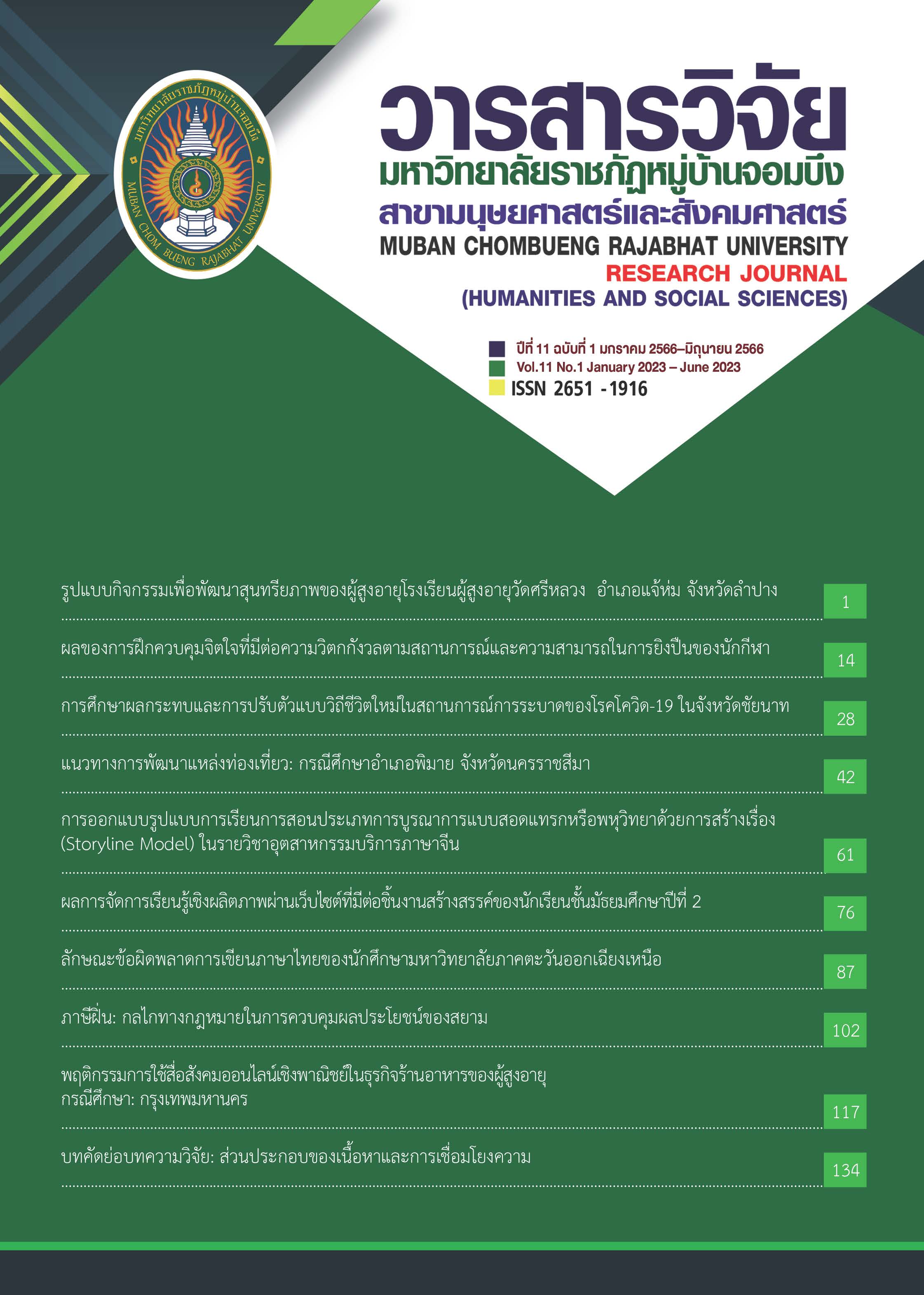แนวทางการพัฒนาแหล่งท่องเที่ยว: กรณีศึกษาอำเภอพิมาย จังหวัดนครราชสีมา
คำสำคัญ:
แนวทาง, การพัฒนา, แหล่งท่องเที่ยวบทคัดย่อ
การวิจัยเชิงคุณภาพมีวัตถุประสงค์ 1. เพื่อศึกษาสภาพการณ์แหล่งท่องเที่ยวของอำเภอพิมาย จังหวัดนครราชสีมา 2. เพื่อศึกษาจุดเด่น จุดด้อย โอกาส และอุปสรรคของอำเภอพิมาย จังหวัดนครราชสีมา และ 3. เพื่อเสนอแนวทางการพัฒนาแหล่งท่องเที่ยวที่เหมาะสมให้กับอำเภอพิมาย จังหวัดนครราชสีมา รวบรวมข้อมูลจากเอกสาร หนังสือ ตำรา บทความ เอกสารอิเล็กทรอนิกส์ งานวิจัยที่เกี่ยวข้อง และการสัมภาษณ์เชิงลึกด้วยแบบสัมภาษณ์แบบกึ่งโครงสร้างกับคนในชุมชนและผู้มีส่วนเกี่ยวข้องกับการท่องเที่ยว วิเคราะห์ข้อมูลโดยการวิเคราะห์เชิงเนื้อหา
ผลการวิจัย พบว่า 1) สภาพการณ์แหล่งท่องเที่ยวของอำเภอพิมาย จังหวัดนครราชสีมา ประกอบด้วย ด้านจุดดึงดูดใจทางการท่องเที่ยว ด้านการเข้าถึงแหล่งท่องเที่ยว ด้านสิ่งอำนวยความสะดวก ด้านการนำเสนอขายบริการแบบครบวงจร ด้านกิจกรรมทางการท่องเที่ยว และด้านบริการเสริม 2) ด้านจุดเด่น โบราณสถานและโบราณวัตถุ ด้านจุดด้อย ขาดการเชื่อมโยงเส้นทางการท่องเที่ยวด้านโอกาส การเข้ามาถ่ายทำรายการ ภาพยนตร์ หรือละครโทรทัศน์ในแหล่งท่องเที่ยวสามารถสร้างแรงจูงใจให้กับนักท่องเที่ยวในการเข้ามาท่องเที่ยวในอำเภอพิมาย และด้านอุปสรรค การเกิดวิกฤต การแพร่ระบาดของไวรัสโรนาสายพันธุ์ใหม่ ส่งผลกระทบต่อระบบเศรษฐกิจของผู้ประกอบการ ในอุตสาหกรรมการท่องเที่ยว 3) แนวทางการพัฒนาแหล่งท่องเที่ยวที่เหมาะสมของอำเภอพิมาย จังหวัดนครราชสีมา ประกอบด้วย แนวทางการพัฒนาโครงสร้างพื้นฐานและสิ่งอำนวยความสะดวก แนวทางการพัฒนาคุณภาพแหล่งท่องเที่ยว สินค้าและบริการด้านการท่องเที่ยวและแนวทางการพัฒนาบุคลากรทางการท่องเที่ยว
เอกสารอ้างอิง
Boontasorn, N., Mana, S. and Poltecha, B. (2014). The Development of Community Marketing and Promote Tourism for Community Business Enterprise for Sustainable Tourism of Hunkad strict, Chainat Province. Chandrakasem Rajabhat University Journal, 20(39), 39-48.
Boonyasathit Mahakhan and Pientam. (2019). The Perception of Local History and the Adaptation and Expression of Phimai People. Academic Journal of Humanities and Social Sciences Burapha University, 27(55), 161-183.
Boonyanusith, N. Kung, S. and Lin, H. (2015).Greenways: an Important Element of Green Infrastructure. NAJUA: Architecture, Design and Built Environment, 29, 387-404.
Buhalis, D.2000.Marketing the competitive destination of the future. Tourism management, 21(1), 97-116.
Chatawanich, S. (2012). A study of the art and cultural sights of Prasat Hin Phiman and Phanom Rung. Journal of Cultural Approach, 13(23), 1-15.
Cresswell, J. W. (2003). Research Design. Thousand Oaks, CA: Sage Publications.
Denzin, N. (1978). Sociological Methods: A Sourcebook. NY: McGraw Hill.
Denzin, N. K., & Lincoln, Y. S. (1994). Preface. In N. K. Denzin & Y. S. Lincoln (Eds.), Handbook of qualitative research. Thousand Oaks, CA: Sage Publications.
Emet, G. and Merba, T. (2017). SWOT Analysis: A Theoretical Review. The Journal of International Social Research, 10(51), 994-1006.Doi Number: http://dx.doi.org/10.17719/jisr.2017.1832.
Kaewsanga, K. and Chamnongsri, N. (2015). Knowledge Management of Creative Tourism in Cultural Tourist Attractions, Phimai District, Nakhon Ratchasima. Suranaree J.Soc. Sci., 9(2), 79-103.
Khuabphimai, C. (2015). The Image of the City Theory Approach to Redevelopment Guidelines for Promoting Tourism in Phimai Town. RMUTI Journal Science and Technology, 8(3), 52-61.
Marshall, B., Cardon, P., Poddar, A., and Fontenot, R. (2013). Does sample size matter in qualitative research? A review of qualitative interviews in IS research. Journal of Computer Information Systems, 54, 11- 22. Doi:10.1080/08874417. 2013.11645667.
Maneenetr, T. (2009). The impact of tourism on local communities from the growth of tourist attractions in the Phimai Historical Park area. Journal of Business, Economics and Communications, 4(1), 17-33.
Ministry of Tourism and Sports. (2016). Thailand Tourism National Plan (2017 – 2021). Bangkok: Office of Security Service the War Veterans Organization of Thailand Press.
Panpinit, S. (2011). Research Techniques in Social Science. Bangkok: June Publishing Company Limited.
Parasakul, L. (2016). Tourist Behaviour. Bangkok: Chulalongkorn University Press.
Potisita, C. (2019). The science and art of Qualitative Research. Bangkok: Amarin Printing and Publishing Public Company Limited.
Shewasukthaworn, W. (2019). “Past-Present-Future” Directions of conservation of the Historical Park in Thailand. Journal of Architecture, Design and Construction Mahasarakham University, 1(2), 8-22.
Sinlapasate, N. (2017). Tourism Industry. Bangkok: Chulalongkorn University Press.
Sutheewasinnon, P. and Pasunon, P. (2016). Sampling Strategies for Qualitative Research. Parichart Journal, Thaksin University, 29(2), 31-48.
The Tambon Administrative Organization in the City of Phimai Thailand. (2018). Local Development Plan. Recovered from 1/3/2021: https://naimeung.go.th/.
Wannathanom, C. (2009). Tourism Industry. Bangkok: Threelada Press.
ดาวน์โหลด
เผยแพร่แล้ว
รูปแบบการอ้างอิง
ฉบับ
ประเภทบทความ
สัญญาอนุญาต
ลิขสิทธิ์ (c) 2023 วารสารวิจัยมหาวิทยาลัยราชภัฏหมู่บ้านจอมบึง สาขามนุษยศาสตร์และสังคมศาสตร์

อนุญาตภายใต้เงื่อนไข Creative Commons Attribution-NonCommercial-NoDerivatives 4.0 International License.
วารสาร TCI อยู่ภายใต้การอนุญาต Creative Commons Attribution-NonCommercial-NoDerivatives 4.0 International (CC BY-NC-ND 4.0) เว้นแต่จะรุบุไว้เป็นอย่างอื่นโปรดอ่านหน้านโยบายของเราสำหรับข้อมูลเพิ่มเติมเกี่ยวกับการเช้าถึงแบบเปิด ลิขสิทธิ์ และการอนุญาต



